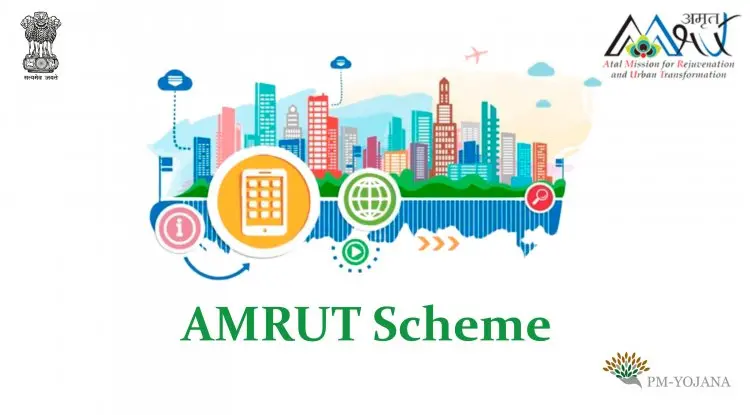AMRUT Scheme
Government of India has launched Atal Mission for Rejuvenation and Urban Transformation (AMRUT) as a Centrally Sponsored Scheme for Urban Development.

AMRUT Scheme
Government of India has launched Atal Mission for Rejuvenation and Urban Transformation (AMRUT) as a Centrally Sponsored Scheme for Urban Development.
Atal Mission
Atal Mission for Rejuvenation and Urban Transformation (AMRUT) was launched in June 2015 by PM Narendra Modi under the Government of India. The AMRUT scheme is an initiative to provide basic civic amenities to the urban areas to improve the quality of life with major focus to the poor and the disadvantaged.
It is the first focused national water Mission, which was launched in 500 cities and covered 60% of the urban population. The scheme is important for the Indian Polity syllabus of the IAS Exam and this article will talk about its important details.
Aspirants can also get a comprehensive List of Government Schemes in India, launched for the social and economic development of the country at the linked article.
Latest Update:
- To mark 6 years of successful completion of the AMRUT Scheme, the Ministry of Housing and Urban Affairs (MoHUA) organized an online event on June 25, 2021. The date also marked the 45 years of establishment of the National Institute of Urban Affairs, an autonomous body of MoHUA, tasked to bridge the gap between research and practice on issues related to urbanization.
- It was announced that as of June 2021, 105 lakh household water tap connections and 78 lakh sewer/ septage connections have been provided under the mission; 88 lakh streetlights have been replaced with energy-efficient LED lights leading to energy savings of 193 crore units
- As per The Energy and Resources Institute (TERI), 84.6 lakh tons carbon footprint have been reduced through various initiatives under the AMRUT Scheme
Key Highlights of AMRUT Scheme
Some of the highlights of the AMRUT scheme are mentioned in the table below:
| AMRUT Scheme | |
| Full-Form | Atal Mission for Rejuvenation and Urban Transformation |
| Year of launching | June 2015 |
| Launched by | PM Narendra Modi |
| Government Ministry | Ministry of Housing and Urban Affairs |
The purpose of Atal Mission for Rejuvenation and Urban Transformation (AMRUT) is to
- Ensure that every household has access to a tap with the assured supply of water and a sewerage connection.
- Increase the amenity value of cities by developing greenery and well maintained open spaces (e.g. parks) and
- Reduce pollution by switching to public transport or constructing facilities for non-motorized transport (e.g. walking and cycling). All these outcomes are valued by citizens, particularly women, and indicators and standards have been prescribed by the Ministry of Housing and Urban Affairs (MoHUA ) in the form of Service Level Benchmarks (SLBs).
Coverage
Five hundred cities have been selected under AMRUT. The category of cities that have been selected under AMRUT is given below:
- All Cities and Towns with a population of over one lakh with notified Municipalities as per Census 2011, including Cantonment Boards (Civilian areas),
- All Capital Cities/Towns of States/ UTs, not covered in above ,
- All Cities/ Towns classified as Heritage Cities by MoHUA under the HRIDAY Scheme,
- Thirteen Cities and Towns on the stem of the main rivers with a population above 75,000 and less than 1 lakh, and
- Ten Cities from hill states, islands and tourist destinations (not more than one from each State).
Objectives of AMRUT Scheme
The AMRUT Scheme focuses on establishing an infrastructure for ensuring adequate sewage networks and water supply in the urban areas through the implementation of the urban revival projects. The first state to submit State Annual Action Plan under the AMRUT scheme was Rajasthan. Various other schemes like Swachh Bharat Mission, Housing for All 2022 and the local state schemes related to water supply, sewerage and infrastructure can also be linked to the AMRUT scheme.
About ₹1 lakh crore investment on urban development under Smart Cities Mission and the Atal Mission for Rejuvenation and Urban Transformation of 500 cities has already been approved by the government
The main objectives of the Atal Mission for Rejuvenation and Urban Transformation (AMRUT) are mentioned below:
- To ensure a proper supply of water and a sewage connection in every household.
- To develop green and well maintained open spaces and parks to increase the amenity value of the cities.
- To reduce pollution by switching to public transport or through the construction of non-motorized transport facilities such as walking and cycling.
- Atal Mission for Rejuvenation and Urban Transformation (AMRUT) aims in covering around 500 cities that are having a population of over one lakh with notified municipalities.
-
Thrust areas
The Mission will focus on the following Thrust Areas:
- water supply,
- sewerage facilities and septage management,
- storm water drains to reduce flooding,
- pedestrian, non-motorized and public transport facilities, parking spaces, and
- enhancing amenity value of cities by creating and upgrading green spaces, parks and recreation centers, especially for children.
Progress made during Phase I
1.1 crore household tap connections and 85 lakh sewer/ septage connections have been provided. 6,000 MLD sewage treatment capacity is being developed, of which 1,210 MLD capacity is already created, with provision for reuse of 907 MLD treated sewage. 1,820 parks with area of 3,600 acre have been developed, while another 1,800 acres of area is under greening. So far, 1,700 flooding points have been eliminated.
AMRUT 2.0
The Atal Mission for Rejuvenation and Urban Transformation 2.0 (AMRUT 2.0) upto 2025-26 was approved by the Cabinet during October 2021 as a step towards AatmaNirbhar Bharat and with aim of making the cities ‘water secure’ and ‘self-sustainable’ through circular economy of water.
Taking forward the remarkable strides made under AMRUT, AMRUT 2.0, targets universal coverage of water supply by providing household tap connections in all 4,378 statutory towns. 100% coverage of household sewerage/ septage management in 500 AMRUT cities is other objective. Mission targets to provide 2.68 crore tap connections and 2.64 crore sewer/ septage connections to achieve the intended outcomes.
Total indicative outlay for AMRUT 2.0 is Rs 2,77,000 crore including central share of Rs 76,760 crore for five years from FY 2021-22 to FY 2025-26.
Mission will be monitored on a robust technology based portal. The projects will be geo-tagged. There will be an endeavor to make it a paper-less Mission. Cities will assess their water sources, consumption, future requirement and water losses through a city water balance plan. Based on this, city water action plans will be prepared which will be summed up as State Water Action Plan and will be approved by the Ministry of Housing and Urban affairs. The funds for the projects will be shared by Centre, State and ULBs. Central funds will be released to the States in three tranches based on allocation to the State as per State Water Action Plan.
Other key features of AMRUT 2.0 (U) include Pey Jal Survekshan which will encourage competition among cities for benchmarking urban water services. Mission will also encourage mobilization of market finance by mandating implementation of 10% of worth of projects in cities with population above ten lakh through Public Private Participation. Mission will also bring in the leading technologies in water sector in world through technology sub-Mission. Entrepreneurs/ start-ups will be encouraged in water eco-system. Information Education and Communication (IEC) campaign will be undertaken to spread awareness among masses about water conservation.
Mission has a reform agenda focussed towards financial health and water security of ULBs. Meeting 20% of water demand through recycled water, reducing non-revenue water to less than 20% and rejuvenation of water bodies are major water related reforms. Reforms on property tax, user charges and enhancing credit worthiness of ULBs are other important reforms. ULBs will be rewarded with incentive on accomplishing the reforms.







